Space Cryogenics Market Size
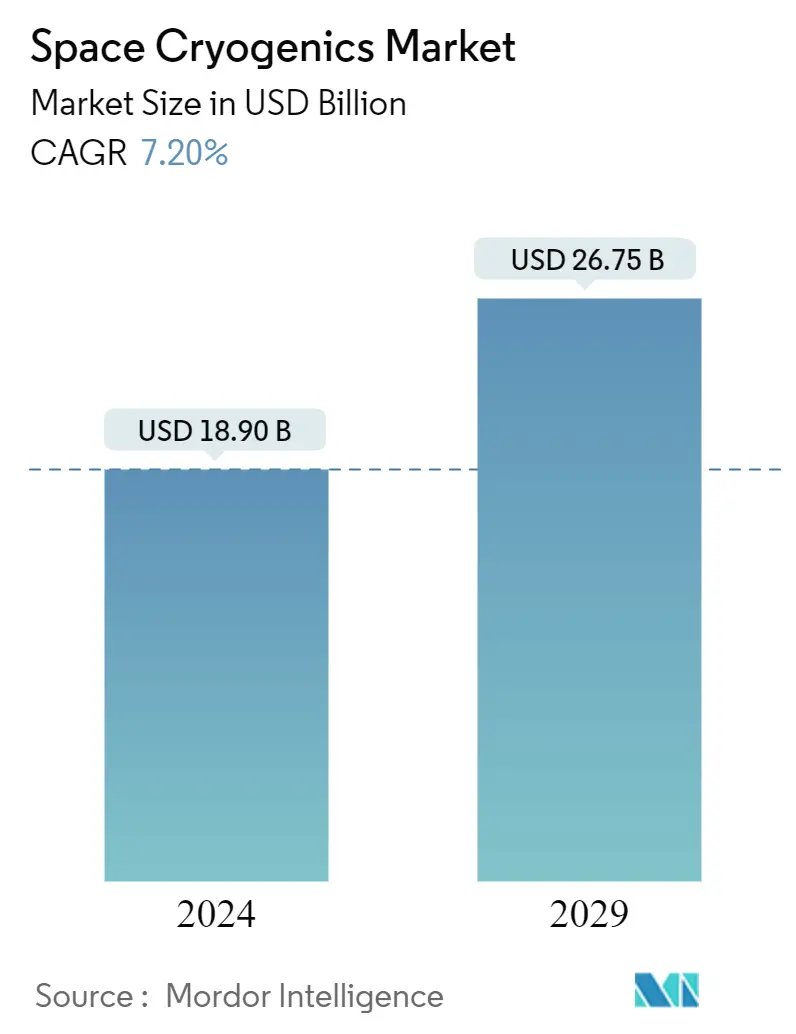
| Study Period | 2019 - 2029 |
| Market Size (2024) | USD 18.90 Billion |
| Market Size (2029) | USD 26.75 Billion |
| CAGR (2024 - 2029) | 7.20 % |
| Fastest Growing Market | Europe |
| Largest Market | North America |
Major Players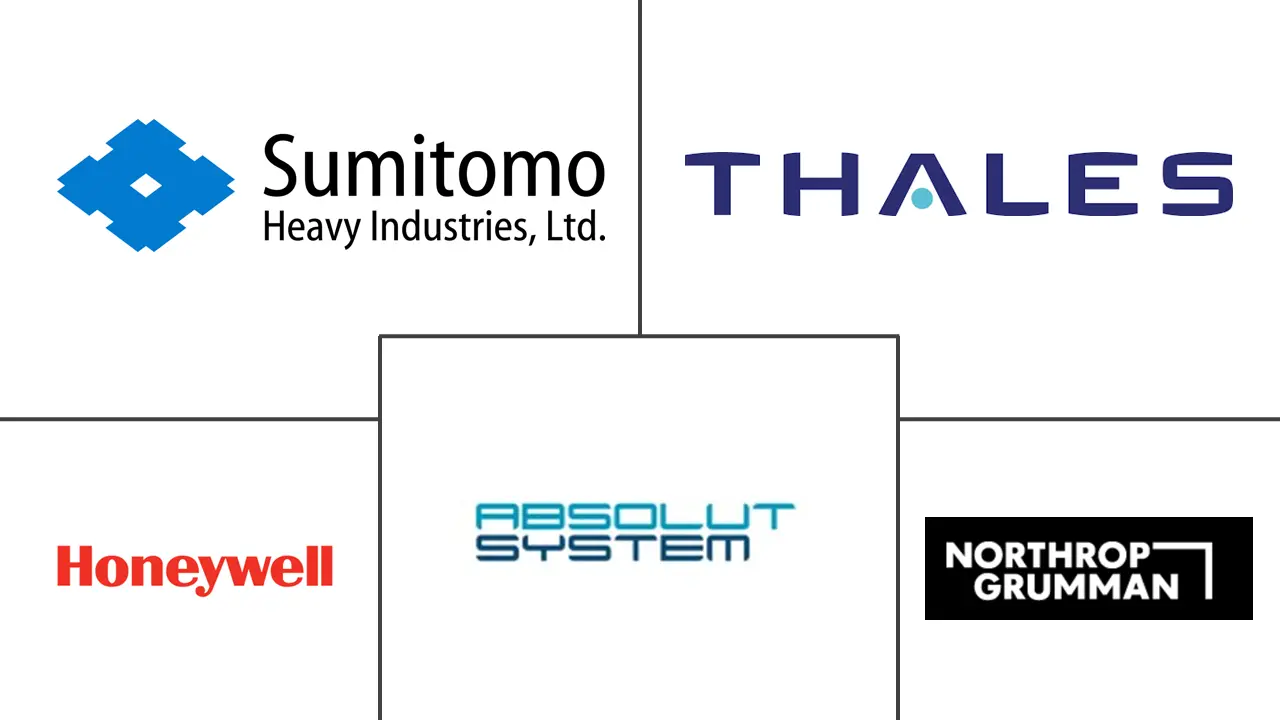
*Disclaimer: Major Players sorted in no particular order |
Space Cryogenics Market Analysis
The Space Cryogenics Market size is estimated at USD 18.90 billion in 2024, and is expected to reach USD 26.75 billion by 2029, growing at a CAGR of 7.20% during the forecast period (2024-2029).
The space cryogenics market growth can be attributed to the increasing simplicity of operations in onboard spacecraft. With space missions becoming more complex, the demand for cryogenic systems that can deliver reliable performance over extended periods is growing.
Advancements in cryogenic technologies are leading to the development of more robust and efficient cryogenic systems to withstand harsh space conditions. Advancements and developments in cryogenic devices, such as sensors and cold electronics in space-based applications, are driving market growth.
Cryogenic sensors and cold electronics are devices that benefit from the development of materials science. Substantial financial investments are required for the development, testing, and deployment of cryogenic infrastructure, which includes storage tanks, insulation, transfer systems, and cooling mechanisms. Hence, high operating expenses and capital expenditures required for cryogenic setups are major factors hindering the growth of the space cryogenics market.
Space Cryogenics Market Trends
The Space Science Missions Segment will Account for the Highest Market Share During the Forecast Period
The space science missions segment is expected to account for the largest share of revenue over the forecast period, owing to the increasing use of cryogenics in space missions. Globally, space organizations have been taking the initiative to launch satellites, rockets, and others. For instance, in May 2023, a second-generation navigation satellite that utilizes a GSLV rocket with a cryogenic upper stage was successfully launched by the Indian Space Research Organization (ISRO). The NVS-01 will supplement the country's regional navigation system by delivering precise and real-time navigation.
In November 2022, the American space agency, NASA, launched the Artemis-1 mission at Florida's Kennedy Space Center. During the launch, the core stage engines shut down eight minutes after liftoff and separated from the rest of the rocket. After this, the Interim Cryogenic Propulsion Stage (ICPS) was used to propel the Orion spacecraft. The four solar panels of the Orion spacecraft were deployed by NASA. Orion decoupled from the ICPS and completed 'translunar injection.' It is now traveling toward the lunar orbit. Such developments are expected to lead the segment during the forecasted years.
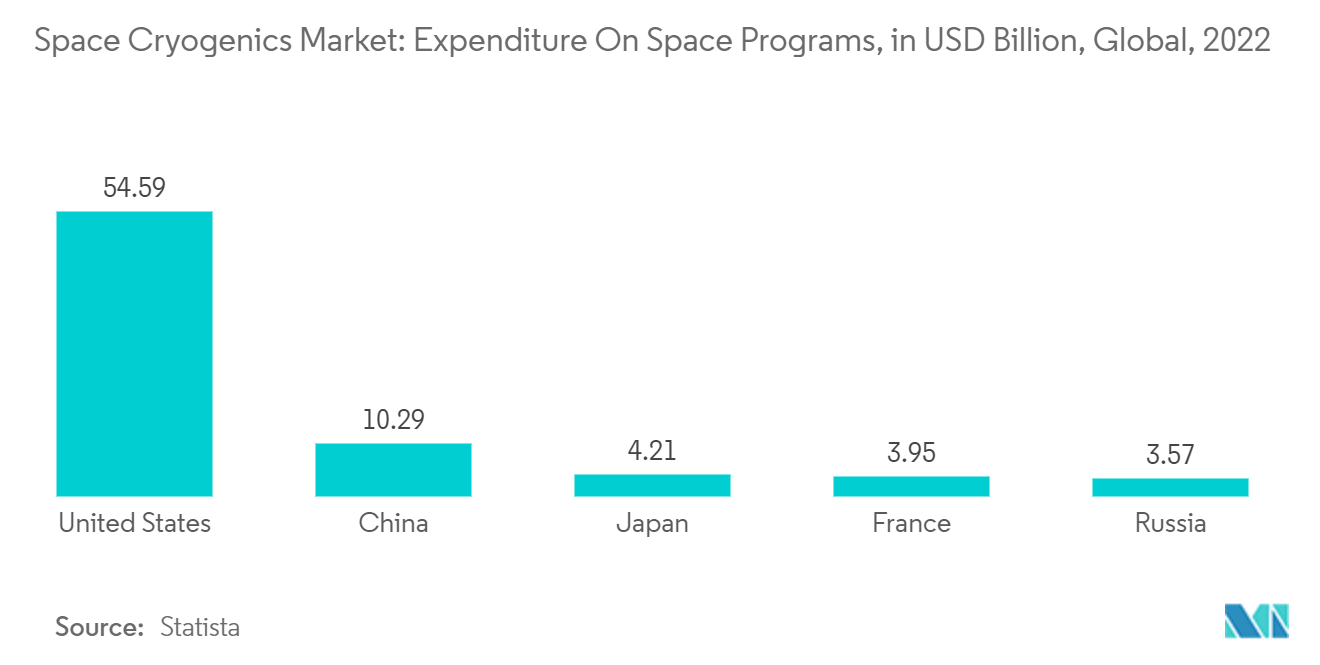
Europe will Witness the Highest Growth During the Forecast Period
In the space cryogenics market, Europe is projected to witness the highest growth as a result of the ongoing and planned space initiatives during the forecast period. For instance, to ensure that the United Kingdom leads the creation of a space telescope to study exoplanets, in 2022, the UK government announced an investment of USD 31.05 million. With this funding, the country is envisioned to continue leading the mission's scientific operations and data processing while also receiving the payload module, cryogenic cooler, and optical ground support equipment for Ariel.
In July 2023, the French parliament approved a seven-year military spending program for 2024-2030 that includes USD 6.7 billion for space programs, which is a 45% increase from the previous period. In September 2023, the German government presented a new Space Strategy and laid its goals and opportunities for space travel until 2030.
In October 2023, the UK Space Agency and a US spaceflight services company, Axiom Space, signed an initial agreement as they bid to send British astronauts into orbit for two weeks. The mission with the UK would be commercially sponsored and supported by the European Space Agency. Hence, increasing activities in the space industry in this region are leading to a rise in demand for space cryogenics, which is expected to drive growth in market revenue.
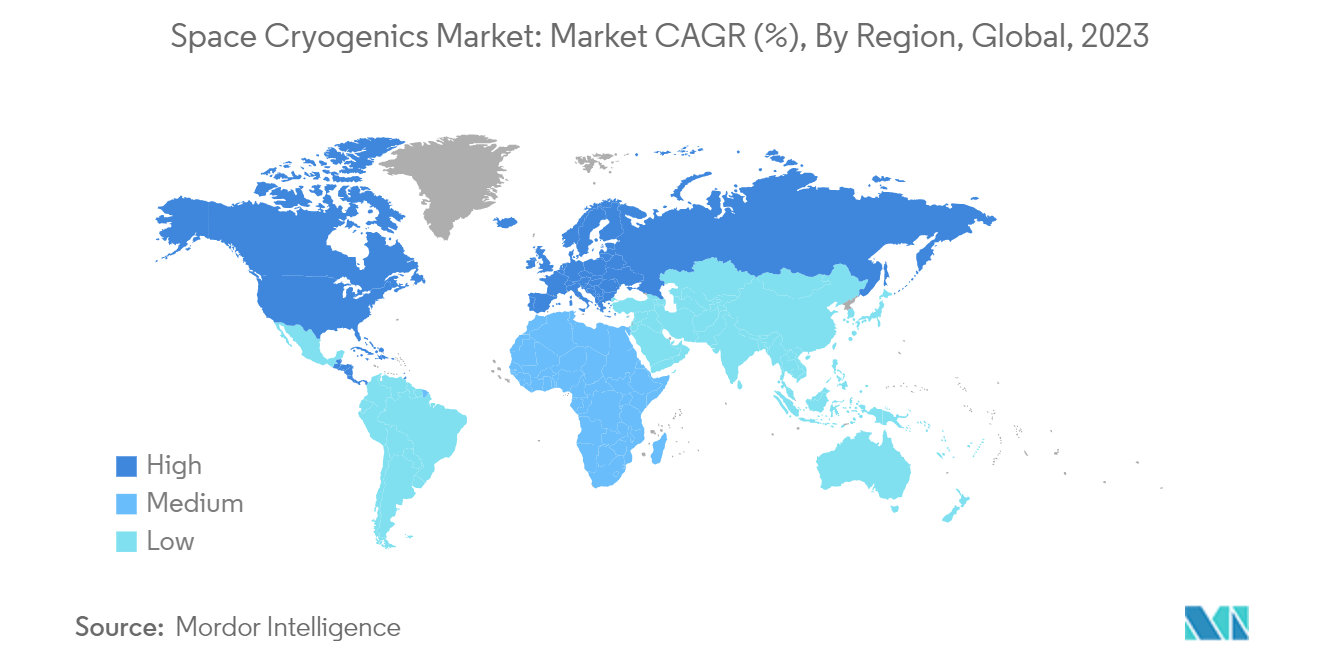
Space Cryogenics Industry Overview
The space cryogenics market is consolidated, with leading players having the highest market share. Some of the key market players include THALES, Northrop Grumman Corporation, Absolut System, Sumitomo Heavy Industries Ltd, and Honeywell International Inc.
These companies are leaders in cryogenic technology and suppliers of cryogenic coolers. Companies are investing in the R&D of cryogenic systems that offer automated controls, remote monitoring, and maintenance capabilities to help streamline spacecraft operations and reduce the risk of human error. By reducing the complexity of cryogenic systems and enhancing their ease of use, spacecraft operators can focus on mission objectives rather than intricate system management.
Space Cryogenics Market Leaders
-
THALES
-
Northrop Grumman Corporation
-
Absolut System
-
Sumitomo Heavy Industries, Ltd.
-
Honeywell International Inc.
*Disclaimer: Major Players sorted in no particular order
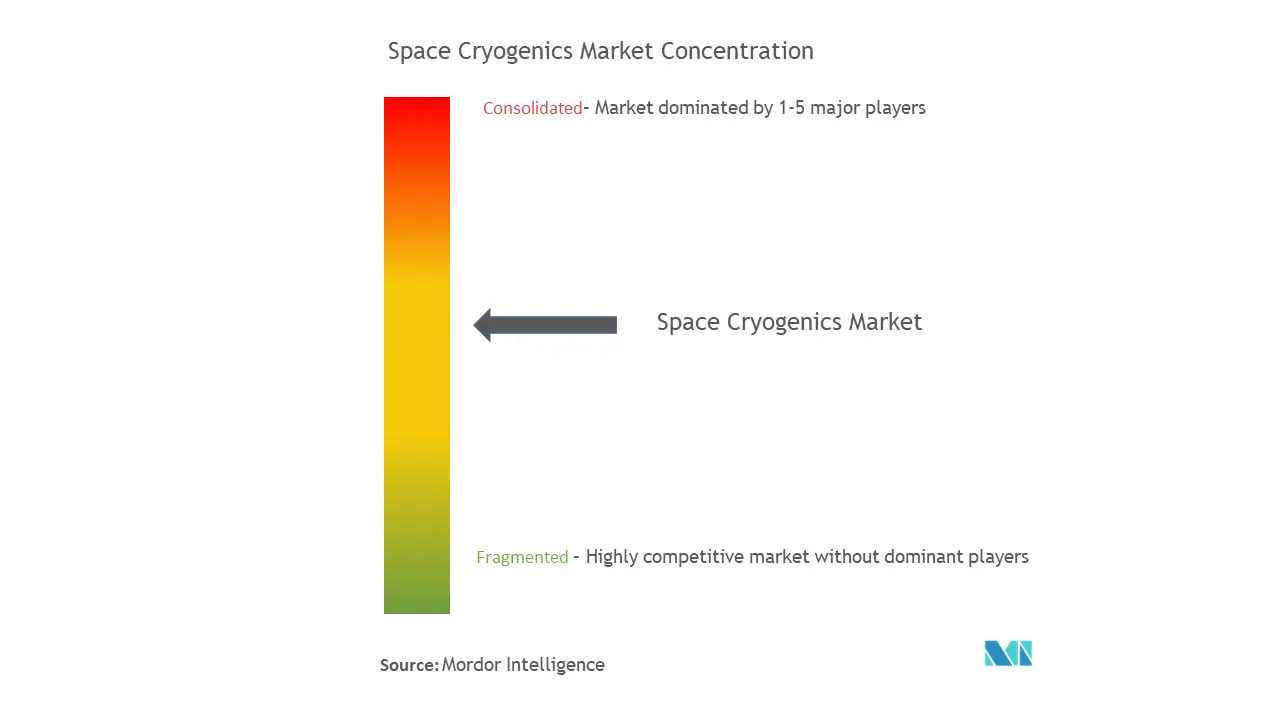
Space Cryogenics Market News
- January 2024: Space Machines Company and Spaceium entered a partnership to embark on the first-ever cryogenic refueling mission in space in 2025. Under this agreement, Spaceium will showcase its cryogenic storage capabilities on the Space Machines Company’s platform.
- April 2023: NASA selected a handful of companies to enhance the capabilities and technologies of NASA's Moon to Mars Objectives through the 2022 Announcement of Collaboration Opportunity (ACO). A group of industry-led teams from the United States will test a novel lunar rover tire design, create a robotically built power system, and construct an electrically operated device to connect in-space propellant transfer lines.
Space Cryogenics Market Report - Table of Contents
1. INTRODUCTION
- 1.1 Study Assumptions
- 1.2 Scope of the Study
2. RESEARCH METHODOLOGY
3. EXECUTIVE SUMMARY
4. MARKET DYNAMICS
- 4.1 Market Overview
- 4.2 Market Drivers
- 4.3 Market Restraints
-
4.4 Porter's Five Force Analysis
- 4.4.1 Threat of New Entrants
- 4.4.2 Bargaining Power of Buyers/Consumers
- 4.4.3 Bargaining Power of Suppliers
- 4.4.4 Threat of Substitute Products
- 4.4.5 Intensity of Competitive Rivalry
5. MARKET SEGMENTATION
-
5.1 By Cooling Type
- 5.1.1 High-Temperature Coolers
- 5.1.2 Low-Temperature Coolers
-
5.2 By Application
- 5.2.1 Earth Observation
- 5.2.2 Telecom Applications
- 5.2.3 Technology Demonstration Missions
- 5.2.4 Cryo-Electronics Applications
-
5.3 By Temperature
- 5.3.1 Less Than 120 K
- 5.3.2 120 K
- 5.3.3 More Than 150K
-
5.4 Geography
- 5.4.1 North America
- 5.4.1.1 United States
- 5.4.1.2 Canada
- 5.4.2 Europe
- 5.4.2.1 Germany
- 5.4.2.2 United Kingdom
- 5.4.2.3 Russia
- 5.4.2.4 France
- 5.4.2.5 Rest of Europe
- 5.4.3 Asia-Pacific
- 5.4.3.1 India
- 5.4.3.2 China
- 5.4.3.3 Japan
- 5.4.3.4 South Korea
- 5.4.3.5 Rest of Asia-Pacific
- 5.4.4 Latin America
- 5.4.4.1 Brazil
- 5.4.4.2 Rest of Latin America
- 5.4.5 Middle East and Africa
- 5.4.5.1 United Arab Emirates
- 5.4.5.2 Saudi Arabia
- 5.4.5.3 Israel
- 5.4.5.4 Rest of Middle East and Africa
6. COMPETITIVE LANDSCAPE
- 6.1 Vendor Market Share
-
6.2 Company Profiles
- 6.2.1 THALES
- 6.2.2 Absolut System
- 6.2.3 Sumitomo Heavy Industries Ltd
- 6.2.4 Air Liquide
- 6.2.5 Oxford Instruments
- 6.2.6 Parker Hannifin Corporation
- 6.2.7 Honeywell International Inc.
- 6.2.8 RICOR
- 6.2.9 Creare
- 6.2.10 Northrop Grumman Corporation
- *List Not Exhaustive
7. MARKET OPPORTUNITIES AND FUTURE TRENDS
** Subject To AvailablitySpace Cryogenics Industry Segmentation
Cryogenics is the field of study of the production and behavior of materials at extremely low temperatures to lift and place heavier objects in space.
The space cryogenics market is segmented by cooling type, application, temperature, and geography. By cooling type, the market is segmented into high-temperature coolers and low-temperature coolers. By application, the market is segmented into earth observation, telecom applications, technology demonstration missions, and cryo-electronics applications. By temperature, the market is segmented into less than 120K, 120K to 150K, and more than 150K. The report also covers the market sizes and forecasts for the space cryogenics market in major countries across different regions. For each segment, the market size is provided in terms of value (USD).
| By Cooling Type | High-Temperature Coolers | |
| Low-Temperature Coolers | ||
| By Application | Earth Observation | |
| Telecom Applications | ||
| Technology Demonstration Missions | ||
| Cryo-Electronics Applications | ||
| By Temperature | Less Than 120 K | |
| 120 K | ||
| More Than 150K | ||
| Geography | North America | United States |
| Canada | ||
| Geography | Europe | Germany |
| United Kingdom | ||
| Russia | ||
| France | ||
| Rest of Europe | ||
| Geography | Asia-Pacific | India |
| China | ||
| Japan | ||
| South Korea | ||
| Rest of Asia-Pacific | ||
| Geography | Latin America | Brazil |
| Rest of Latin America | ||
| Geography | Middle East and Africa | United Arab Emirates |
| Saudi Arabia | ||
| Israel | ||
| Rest of Middle East and Africa |
Space Cryogenics Market Research FAQs
How big is the Space Cryogenics Market?
The Space Cryogenics Market size is expected to reach USD 18.90 billion in 2024 and grow at a CAGR of 7.20% to reach USD 26.75 billion by 2029.
What is the current Space Cryogenics Market size?
In 2024, the Space Cryogenics Market size is expected to reach USD 18.90 billion.
Who are the key players in Space Cryogenics Market?
THALES, Northrop Grumman Corporation, Absolut System, Sumitomo Heavy Industries, Ltd. and Honeywell International Inc. are the major companies operating in the Space Cryogenics Market.
Which is the fastest growing region in Space Cryogenics Market?
Europe is estimated to grow at the highest CAGR over the forecast period (2024-2029).
Which region has the biggest share in Space Cryogenics Market?
In 2024, the North America accounts for the largest market share in Space Cryogenics Market.
What years does this Space Cryogenics Market cover, and what was the market size in 2023?
In 2023, the Space Cryogenics Market size was estimated at USD 17.54 billion. The report covers the Space Cryogenics Market historical market size for years: 2019, 2020, 2021, 2022 and 2023. The report also forecasts the Space Cryogenics Market size for years: 2024, 2025, 2026, 2027, 2028 and 2029.
Space Cryogenics Industry Report
Statistics for the 2024 Space Cryogenics market share, size and revenue growth rate, created by Mordor Intelligence™ Industry Reports. Space Cryogenics analysis includes a market forecast outlook for 2024 to 2029 and historical overview. Get a sample of this industry analysis as a free report PDF download.



